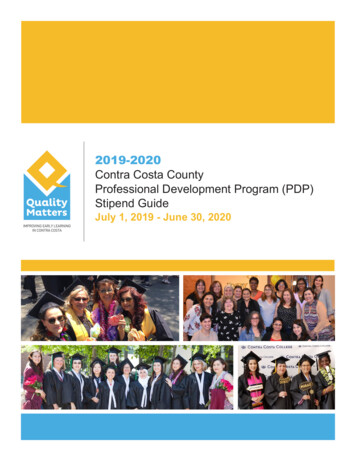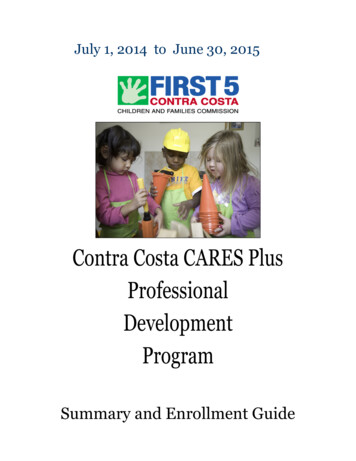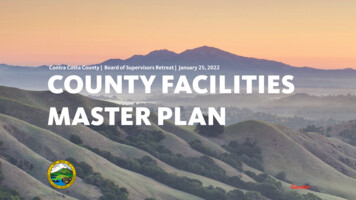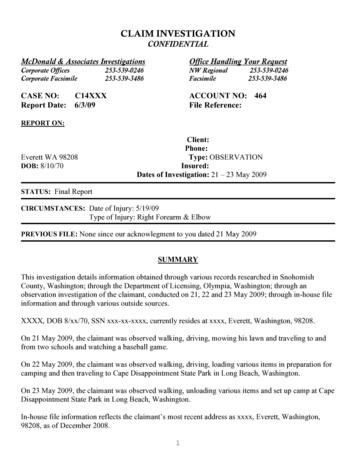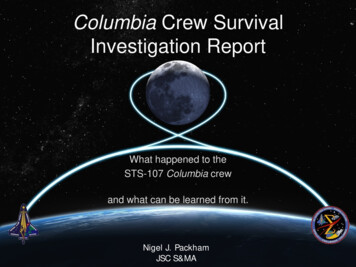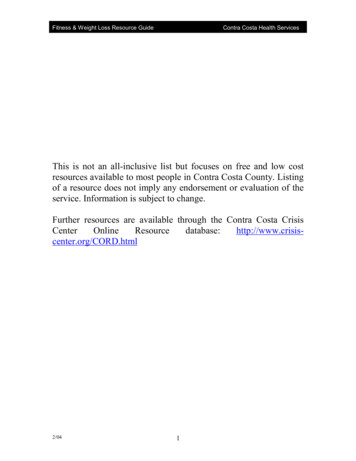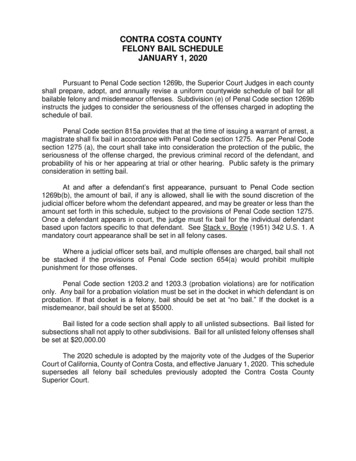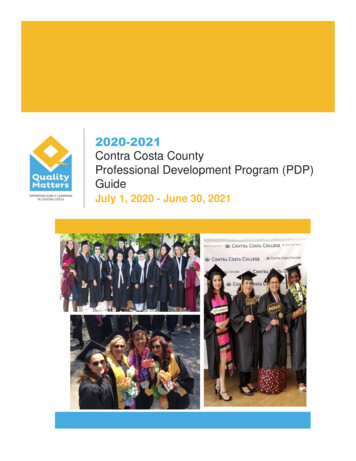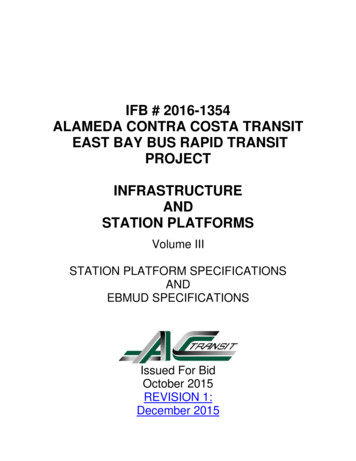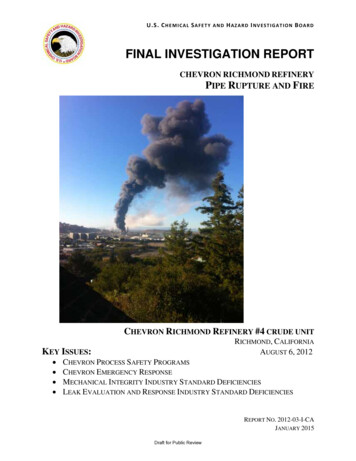
Transcription
U.S. C H E M I C A L S A F E T Y A N D H A Z A R D I N V E S T I G A T I O N B O A R DFINAL INVESTIGATION REPORTCHEVRON RICHMOND REFINERYPIPE RUPTURE AND FIRECHEVRON RICHMOND REFINERY #4 CRUDE UNITRICHMOND, CALIFORNIAAUGUST 6, 2012KEY ISSUES: CHEVRON PROCESS SAFETY PROGRAMSCHEVRON EMERGENCY RESPONSEMECHANICAL INTEGRITY INDUSTRY STANDARD DEFICIENCIESLEAK EVALUATION AND RESPONSE INDUSTRY STANDARD DEFICIENCIESREPORT NO. 2012-03-I-CAJANUARY 2015Draft for Public Review
Chevron Richmond RefineryInvestigation ReportJanuary 2015[This page intentionally left blank.]iiU.S. CHEMICAL SAFETY AND HAZARD INVESTIGATION BOARDDraft for Public Review
Chevron Richmond RefineryInvestigation ReportJanuary 2015Table of Contents1.0Executive Summary . 11.1Incident Summary . 11.2Chevron Interim Report . 21.3Chevron Regulatory Report . 41.4Chevron Final Investigation Report . 51.4.1Technical Findings . 51.4.2Organizational Findings . 71.4.3Emergency Response Findings . 121.4.4Safety Culture Findings . 131.4.5Industry Codes and Standards Findings . 141.4.6Regulatory Findings . 141.5Recommendations . 152.0Richmond Refinery Process Description . 172.1Chevron Background . 172.2Richmond Refinery . 172.3#4 Crude Unit . 182.44-Sidecut Line . 193.0The Incident. 223.1Leak Discovery . 223.2Leak Response . 253.3Consequences . 294.0Technical Analysis . 344.1Sulfidation Corrosion . 344.2Sulfidation Corrosion Inspection Techniques . 414.3Silicon Characterization Techniques . 434.4Inherently Safer Design . 455.0Incident Analysis . 485.1Organizational Analysis . 505.1.15.1.1.1ETC Sulfidation Failure Prevention Guidance . 545.1.1.2Chevron ETC Conclusions. 565.1.2iiiChevron Energy Technology Company . 53Chevron Turnaround Management . 58U.S. CHEMICAL SAFETY AND HAZARD INVESTIGATION BOARDDraft for Public Review
Chevron Richmond Refinery5.1.2.1Recommendations Regarding 4-Sidecut Line for 2007 Turnaround . 602011 Crude Unit Turnaround . 645.1.2.2.15.1.2.3January 20152007 Crude Unit Turnaround . 595.1.2.1.15.1.2.2Investigation ReportRecommendations Regarding 4-Sidecut Line for 2011 Turnaround . 65Chevron Richmond Refinery Turnaround-Planning Conclusions . 665.1.3Chevron Unit Reliability Improvement Process . 685.1.4Chevron Fixed Equipment Reliability Business Improvement Network . 715.1.5Chevron Minimum Pipe Thickness Program . 745.1.6Chevron Process Safety Indicators Program . 785.1.7Stop Work Authority. 795.1.8Chevron Organizational Conclusions . 835.2Industry Sulfidation Corrosion Guidance . 855.2.1 API RP 939-C: Guidelines for Avoiding Sulfidation (Sulfidic) Corrosion Failures in OilRefineries . 855.2.2API RP 571: Damage Mechanisms Affecting Fixed Equipment in the Refining Industry . 895.2.3API 570: Piping Inspection Code: In-Service Inspection, Rating, Repair, and Alteration ofPiping Systems . 905.2.4API RP 578: Material Verification Program for New and Existing Alloy Piping Systems . 915.2.5API RP 574: Inspection Practices for Piping System Components . 915.3Chevron Emergency Response to Process Leaks. 925.3.1Area Control and Hazardous Area Assessment . 925.3.2Miscommunication regarding 4-sidecut properties . 935.3.3Leak Mitigation and Discovery Attempts Worsened Leak . 945.3.4Chevron’s New Leak Response Protocol. 975.3.5Leak Response Conclusions. 1005.4Industry Leak Response Guidance . 1005.4.1API RP 574: Inspection Practices for Piping System Components . 1005.4.2API RP 2001: Fire Protection in Refineries . 1015.4.3API 570: Piping Inspection Code: In-Service Inspection, Rating, Repair, and Alteration ofPiping Systems . 1035.4.4ASME PCC-2-2011: Repair of Pressure Equipment and Piping . 1035.4.5Industry Leak Response Guidance Conclusions . 1045.5Chevron Richmond Refinery Safety Culture . 1045.5.1ivNormalization of Deviance . 105U.S. CHEMICAL SAFETY AND HAZARD INVESTIGATION BOARDDraft for Public Review
Chevron Richmond Refinery5.5.2Investigation ReportJanuary 2015Chevron Richmond Refinery Safety Culture Surveys . 1065.5.2.1Stop Work Authority Safety Culture Survey Responses . 1075.5.2.2Mechanical Integrity Safety Culture Survey Responses . 1085.5.2.3Process Safety Analysis Safety Culture Survey Responses . 1095.5.2.4Regulator Overview of Safety Culture Survey Action Items . 1106.0Recommendations . 1126.1American Petroleum Institute . 1126.2American Society of Mechanical Engineers . 1156.3Chevron USA . 1156.4Board of Supervisors, Contra Costa County, California . 1166.5Mayor and City Council, City of Richmond, California . 116Appendix A—Chevron Leak Response Protocol Developed Post-incident . 117Appendix B—Contra Costa County Community Warning System . 120Appendix C—Usage of Clamps at Chevron Richmond Refinery . 121vU.S. CHEMICAL SAFETY AND HAZARD INVESTIGATION BOARDDraft for Public Review
Chevron Richmond RefineryInvestigation ReportJanuary 2015List of FiguresFigure 1.Figure 2.Figure 3.Figure 4.Figure 5.Figure 6.Figure 7.To-scale schematic of 4-sidecut piping identifying key wall thickness values. . 11Aerial view of the Chevron Richmond Refinery. . 18Schematic of C-1100 Crude Unit atmospheric column and upstream process equipment. . 204-sidecut line configuration and rupture location. . 21Photo of rupture on 4-sidecut 52-inch component. . 22CSB animation depicting operator identifying the leaking 4-sidecut pipe. . 23Photo taken of the leaking 4-sidecut pipe on August 6, 2012, at the Chevron RichmondRefinery. 24Figure 8. Timeline of events on August 6, 2012. . 25Figure 9. Example leak repair clamp for piping. It is installed over the leak location to prevent processfluid leakage to the atmosphere. . 26Figure 10. CSB animation of contractors erecting scaffolding beneath the leak location. . 27Figure 11. CSB animation of firefighters attempting to remove the 4-sidecut insulation, the resulting fire,and fire extinguishing. 28Figure 12. CSB animation of firefighters who dropped to their hands and knees to escape the vaporcloud. 29Figure 13. CSB animation of firefighter who was inside the fire engine when the light gas oil ignited. . 31Figure 14. Photo of the burned remains of the fire truck that was consumed by the fire. . 32Figure 15. Initial vapor cloud formation (white cloud) and subsequent ignition (black smoke) as seen froma pier in San Francisco, California. . 33Figure 16. Vapor cloud and ignition seen from Marin County. . 34Figure 17. Graph of sulfidation corrosion rates with respect to silicon content in carbon steel . 36Figure 18. Locations of metallurgical samples taken from 8-inch 4-sidecut piping post-incident. . 38Figure 19. Locations of metallurgical samples taken from 12-inch 4-sidecut piping post-incident. . 39Figure 20. 4-sidecut piping sample (E-017-8) analyzed by Anamet Labs showing the relative thickness oflow silicon piping on the left and the high silicon piping on the right. . 40Figure 21. CML placement on 8-inch 4-sidecut piping. . 42Figure 22. Modified McConomy Curves from API RP 939-C. . 45Figure 23. Hierarchy of controls . 46Figure 24. Acci-Map of August 6, 2012, Chevron Refinery Fire. . 49Figure 25. Organizational decision-making schematic showing attempts to have carbon steel 4-sidecutpiping 100 percent component inspected or replaced with a higher chromium steel alloy . 50Figure 26. Key events at the Richmond refinery between 2002 and 2012. . 51Figure 27. Chevron Corporation refinery process safety programs. . 52Figure 28. Chevron Energy Technology Company (ETC) organizational roles. 54Figure 29. Presentation slide of ETC training course that guided refinery staff to perform 100 percentcomponent inspection on high-temperature lines susceptible to sulfidation corrosion. 55Figure 30. Presentation slide of ETC training course that guided refinery staff on ways to reduce riskfrom sulfidation corrosion. . 56Figure 31. Work list criteria requirements specified in the Framing Document used during Chevron’s2007 Crude Unit turnaround. . 60viU.S. CHEMICAL SAFETY AND HAZARD INVESTIGATION BOARDDraft for Public Review
Chevron Richmond RefineryInvestigation ReportJanuary 2015Figure 32. Sample Inspection Database report analyzed by unit inspectors when determining pipingremaining life and when making piping replacement recommendations . 61Figure 33. Crude column schematic indicating the piping downstream of the 4-sidecut pumps that wasreplaced during the 2007 Crude Unit turnaround . 63Figure 34. Work list criteria requirements specified in the Framing Document used during Chevron’s2011 Crude Unit turnaround. . 64Figure 35. Presentation slide showing corporate reliability leader’s findings that the Richmond Refinerywas not complying with the ETC Sulfidation Failure Prevention Initiative. . 73Figure 36. To-scale schematic of 4-sidecut piping original wall thickness (0.322-inch), Minimum AlertThickness (0.13-inch), and Minimal Required Thickness (0.11-inch) using API RP 574 defaultvalues. . 75Figure 37. Text from Chevron design engineer indicating structural minimum thickness (t(min))calculation results for small sections of suction piping upstream of the 4-sidecut pumps. . 76Figure 38. Photo from API RP 939-C of a low-silicon pup piece that ruptured at a BP refinery . 86Figure 39. Schematic from API RP 939-C of the piping shown in Figure 38. . 87Figure 40. Photo of undamaged (top) and burned during incident (bottom) pike pole used in earlyattempts to remove 4-sidecut insulation. 95Figure 41. Photo showing that tip of fire pole matches apparent puncture location in failed 52-inchcomponent of 4-sidecut piping. . 96Figure 42. Ideal communication flow to Incident Commander during refinery process fluid leak incident. 98Figure 43. Chevron’s new Leak Response Protocol, developed post-incident . 99viiU.S. CHEMICAL SAFETY AND HAZARD INVESTIGATION BOARDDraft for Public Review
Chevron Richmond RefineryInvestigation ReportJanuary 2015List of TablesTable 1. Silicon characterization technique. . 43Table 2. Total number of employees surveyed and job functions of respondents in 2008 and 2010Chevron Richmond Refinery staff safety culture surveys. . 106Table 3. Chevron Richmond Refinery 2008 Safety Culture Survey responses to question of “StoppingUnsafe Work” by operators and mechanics . 107Table 4. Chevron Richmond Refinery 2008 and 2010 Safety Culture Survey responses to question of“Stopping Unsafe Work” by managers and engineers . 108Table 5. Chevron Richmond Refinery 2008 and 2010 Safety Culture Survey responses to question of“How do people feel about stopping unsafe work?” by operators and mechanics. 108Table 6. Chevron Richmond Refinery 2008 and 2010 Safety Culture Survey responses to the question:“How do we take care of equipment?” . 109Table 7. Chevron Richmond Refinery 2008 and 2010 Safety Culture Survey responses to the question“Process Safety Issues Are ” . 109viiiU.S. CHEMICAL SAFETY AND HAZARD INVESTIGATION BOARDDraft for Public Review
Chevron Richmond RefineryInvestigation ReportJanuary 2015Acronyms and Abbreviations⁰C⁰FABUA/CAcciMapAPIAPI 570API RP 2001API RP 571API RP 574API RP 578API RP 754API RP 939-Cdegrees Celsiusdegrees FahrenheitArea Business UnitAdditional ConsiderationsAccident MapAmerican Petroleum InstitutePiping Inspection Code: In-Service Inspection, Rating, Repair, andAlteration of Piping SystemsFire Protection in RefineriesDamage Mechanisms Affecting Fixed Equipment in the RefiningIndustryInspection Practices for Piping System ComponentsMaterial Verification Program for New and Existing Alloy PipingSystemsProcess Safety Performance Indicators for the Refining andPetrochemical IndustriesGuidelines for Avoiding Sulfidation (Sulfidic) Corrosion Failures inOil RefineriesAPI Recommended PracticeAPI RPASMEASME PCC-2-2011ASTMbpdAmerican Society of Mechanical EngineersRepair of Pressure Equipment and PipingAmerican Society for Testing and Materialsbarrels per dayC/ACMLCrCSCSBCWSDRBETCFER BINIMPACTISOMoCorrective ActionsCondition Monitoring LocationChromiumCarbon SteelU.S. Chemical Safety and Hazard Investigation BoardCommunity Warning SystemDecision Review BoardChevron Energy Technology CompanyFixed Equipment Reliability Business Improvement NetworkInitiative for Managing Pacesetter TurnaroundsIndustrial Safety OrdinanceMolybdenumixU.S. CHEMICAL SAFETY AND HAZARD INVESTIGATION BOARDDraft for Public Review
Chevron Richmond RefineryMOCNFPANFPA SSMESTLSWAT-minTMLTOPURBURIPUTxInvestigation ReportJanuary 2015Management of ChangeNational Fire Protection AssociationRecommended Practice for Responding to Hazardous MaterialsIncidentsOperational Excellence and Reliability IntelligenceProcess Hazard AnalysisPositive Material IdentificationPersonal Protective Equipmentpounds per square inch gaugeProcess Safety ManagementRecognized and Generally Accepted Good Engineering PracticesRichmond Industrial Safety OrdinanceRichmond Lube Oil ProjectRadiographic TestingShutdownSiliconshelter-in-placeSafety Instrumented SystemsSubject Matter ExpertShift Team LeaderStop Work Authorityminimum thicknessThickness Measurement Location or Thickness Monitoring LocationTriangle of PreventionUnit Reliability BriefUnit Reliability Improvement ProcessUltrasonic TestingU.S. CHEMICAL SAFETY AND HAZARD INVESTIGATION BOARDDraft for Public Review
Chevron Richmond RefineryInvestigation ReportJanuary 20151.0 Executive Summary1.1 Incident SummaryOn August 6, 2012, the Chevron U.S.A. Inc. Refinery in Richmond, California (“the Chevron RichmondRefinery”) experienced a catastrophic pipe rupture in the #4 Crude Unit. The incident occurred frompiping referred to as the “4-sidecut” stream, one of several process streams exiting the refinery’s C-1100Crude Unit Atmospheric Column.1 The pipe rupture occurred on a 52-inch long component2 of the 4sidecut 8-inch line (the 52-inch component). At the time of the incident, light gas oil3 was flowingthrough the 8-inch line at a rate of approximately 10,800 barrels per day (bpd).4The ruptured pipe released flammable, high temperature light gas oil, which then partially vaporized intoa large, opaque vapor cloud that engulfed 19 Chevron U.S.A. Inc. (Chevron) employees.5 At 6:33 p.m.,approximately two minutes following the release, the released process fluid ignited.6 Eighteen of theemployees safely escaped from the vapor cloud just before ignition; one employee, a Chevron refineryfirefighter, was inside a fire engine that was caught within the fireball when the process fluid ignited.Because he was wearing full-body fire-fighting protective equipment, he was able to make his waythrough the flames to safety. Six Chevron employees suffered minor injuries during the incident andsubsequent emergency response efforts.The release, ignition, and subsequent burning of the hydrocarbon process fluid resulted in a large plumeof vapor, particulates, and black smoke, which traveled across the surrounding area. This chain of eventsresulted in a Community Warning System (CWS) Level 3 alert,7 and a shelter-in-place8 advisory (SIP)was issued at 6:38 p.m.9 for the cities of Richmond, San Pablo, and North Richmond. It was lifted later1The atmospheric column separates crude oil feed into different streams through distillation. These streams arefurther processed in other units in the refinery. The location of the 4-sidecut, light gas oil stream was shown inFigure 4 (page 12) of the Interim Investigation Report Chevron Richmond Refinery Fire. Seehttp://www.csb.gov/assets/1/19/Chevron Interim Report Final 2013-04-17.pdf (accessed January 21, 2015).2“Component” refers to a portion of piping between welds. It includes straight run piping and pipe fittings.3Light gas oil is a component of crude oil with a boiling point range between 401 F and 653 F.4This quantity is the equivalent of 315 gallons per minute (gpm). A barrel is equivalent to 42 gallons.5This number is based on statements made to the CSB by each of the 19 employees caught in the vapor cloud.6Surveillance footage was provided by Chevron. Chevron clarified to the CSB that the video time stamp isapproximately 5 minutes out of sync. The video is available athttp://www.csb.gov/videoroom/detail.aspx?VID 69 (accessed February 8, 2013).7A Community Warning System Level 3 alert indicates that a facility within Contra Costa County has had a releasethat has offsite impact and is categorized by any of the following conditions:1. Off-site impact that may cause eye, skin, nose and/or respiratory irritation to the general population.2. Fire, explosion, heat, or smoke with an off-site impact. Example: On a process unit/storage tank wheremutual aid is requested to mitigate the event and the fire will last longer than 15 minutes.3. Hazardous material or fire incident where the Incident Commander or unified command, throughconsultation with the Contra Costa Health Services Hazardous Material Incident Response Team, requeststhat sirens should be sounded.See http://cchealth.org/hazmat/pdf/incident notification policy.pdf (accessed April 9, 2013).8Contra Costa County considers a shelter-in-place to include going inside a home or nearest building, closing doorsand windows, and turning off heating, ventilation, and air conditioning. See p (accessed February 6, 2013).9Chevron U.S.A. Inc. "30 Day Follow-Up Notification Report," September 5, 2012.1U.S. CHEMICAL SAFETY AND HAZARD INVESTIGATION BOARDDraft for Public Review
Chevron Richmond RefineryInvestigation ReportJanuary 2015that night, at 11:12 p.m., after the fire was fully under control. In the weeks following the incident,approximately 15,000 people from the surrounding communities sought medical treatment at nearbymedical facilities for ailments including breathing problems, chest pain, shortness of breath, sore throat,and headaches. Approximately 20 of these people were admitted to local hospitals as inpatients fortreatment.101.2 Chevron Interim ReportThe U.S. Chemical Safety Board (CSB) released its first report on the Chevron incident in April 2013(“the Interim Report”), which highlighted technical findings and safety system deficiencies. The reportissued recommendations to Chevron; the city of Richmond, California; Contra Costa County, California;the State of California; the California Air Quality Management Divisions; the California EnvironmentalProtection Agency; and the U.S. Environmental Protection Agency, summarized below. As of January2015, these groups have made progress in implementing the recommendations, summarized below, toimprove the regulatory requirements for petroleum refineries in California.Chevron U.S.A (Urgent)At all Chevron U.S. refineries and as part of the Process Hazard Analysis cycle, engage a diverse team ofqualified personnel to perform a documented damage mechanism hazard review that identifies potentialprocess damage mechanisms and consequences of failure and ensures safeguards are in place to controlhazards presented by those damage mechanisms. Include in this review applicable industry best practices,Chevron Energy Technology Company findings and recommendations, and inherently safer systems tothe greatest extent feasible. Report leading and lagging process safety indicators at all California ChevronU.S.A. refineries to the applicable regulatory agencies.Mayor and City Council, City of Richmond, California; Board of Supervisors,Contra Costa County, California; California State Legislature, Governor ofCaliforniaRequire that Process Hazard Analyses include documentation of the recognized methodologies, rationaleand conclusions used to claim that safeguards intended to control hazards will be effective. Require thedocumented use of inherently safer systems analysis and the hierarchy of controls to the greatest extentfeasible in establishing safeguards for identified process hazards. The goal shall be to drive the risk ofmajor accidents to As Low As Reasonably Practicable (ALARP).California State Legislature, Governor of CaliforniaRequire California petroleum refineries to engage a diverse team of qualified personnel to perform adocumented damage mechanism hazard review as part of the Process Hazard Analysis cycle thatidentifies potential process damage mechanisms and consequences of failure and ensures safeguards are102Based on information provided to the CSB by local hospitals.U.S. CHEMICAL SAFETY AND HAZARD INVESTIGATION BOARDDraft
API American Petroleum Institute API 570 Piping Inspection Code: In-Service Inspection, Rating, Repair, and Alteration of Piping Systems API RP 2001 Fire Protection in Refineries API RP 571 Damage Mechanisms Affecting Fixed Equipment in the Refining Industry API
